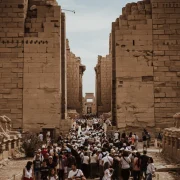
Egypt Luxor Tour: Top 10 Landmarks You Can’t Miss on the East and West Banks
Luxor Egypt Tour is an exciting experience that will take you into the secrets of the pharaohs, revealing the mysteries of the pharaohs’ inscriptions, from the Karnak Temple to the Valley of the Kings and Queens, to the Temple of Hatshepsut and the colossal Colossi of Memnon.
Egypt Luxor Tour, organized by Egypt Travel, is specially designed for you to create exciting and unforgettable memories, amidst the most prominent historical landmarks spread along both banks of the Nile in Upper Egypt. Your day will be filled with numerous attractions on the East Bank of Luxor, which embodies life, and the West Bank, which represents the afterlife.
It is teeming with the tombs of kings, queens, and nobles, as well as evidence of the progress of ancient Egyptian architecture and power.
Table of Contents
ToggleEgypt Luxor Tour opportunity to explore the landmarks of the East Bank:
Karnak Temple
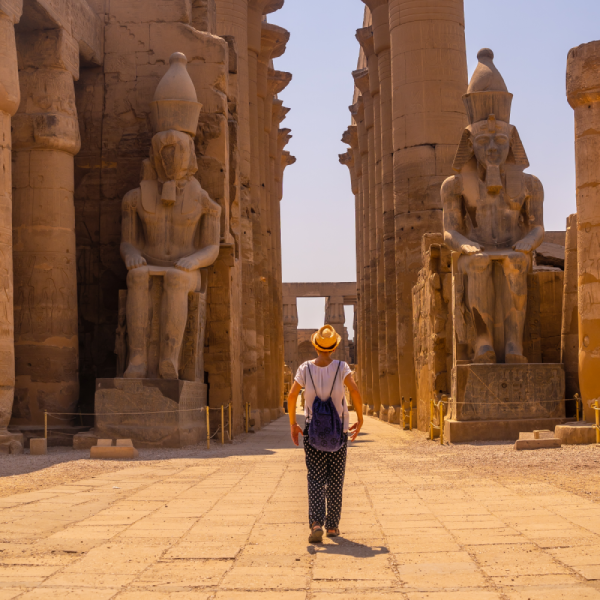
Egypt Luxor Tour gives you a sense of grandeur as you wander among the 134 massive columns at the base of the columns at Karnak Temple amidst an atmosphere of awe-inspiring spirituality. Visit one of the greatest architectural achievements in ancient Egyptian history. Karnak Temple is the largest temple complex in the world in a single location, located on the East Bank of Luxor. It is an important religious center for the worship of the god Amennon, his wife Mut, and his son Khonsu.
The Karnak Temple is distinguished by its massive gates, spacious halls, and giant columns, some of which reach heights of more than 20 meters. These columns are decorated with inscriptions and ornaments that tell the stories of kings and gods over thousands of years.
During the Egypt Luxor Tour, you will enjoy a majestic atmosphere amidst the inscriptions that tell history as if it were a living reality.
Luxor Temple

Transportation through time is crystallized by the Egypt Luxor Tour, where the bus stops to transport you back in time to 1400 BC as soon as you enter. You’ll wander through the halls of Luxor Temple, built by King Amenhotep III and completed by King Ramses II.
It was the center of religious celebrations, especially the famous Opet Festival, which linked the Karnak and Luxor temples in a majestic festive procession on the banks of the Nile.
The Egypt Luxor Tour gives you the opportunity to explore the magnificent architectural design and details of Luxor Temple, a blend of beauty and grandeur. You’ll be greeted by two colossal statues of Ramses II, passing through the spacious courtyards and the Hypostyle Hall, decorated with inscriptions that tell many historical stories about the ancient kings and their victories.
Luxor Museum
Egypt Luxor Tour will make you realize that the East Bank still has a rich history dating back 7,000 years. Nestled along the Nile Corniche and nestled between the Luxor and Karnak Temples, the halls of the Luxor Museum house many rare artifacts and relics from the ancient city of Thebes. The artifacts still retain their luster, as if they were made only yesterday.
The museum contains rare statues of New Kingdom kings such as Amenhotep III, Ramses II, and Thutmose III, in addition to statues of the gods Amun, Mut, and Khonsu. The Luxor Museum also houses many exhibits dating back to the Amarna period, as well as tools and objects from daily life, along with wall paintings from the Theban tombs. You can explore the museum’s many different sections, including the Deir el-Bahari Cache Hall, where the mummies of Ramses I and Ahmose I lie, along with other mummies discovered in the Deir el-Bahari Cache in 1881.
Mummification Museum
Egypt Luxor Tour takes you on a journey to explore the secrets and art of mummification among the ancient Egyptians, stopping at an important historical site that holds many secrets recounted within its walls. Located on the East Bank of the Nile, the Mummification Museum is located there. There, you will learn about the rituals the pharaohs used to preserve bodies after death to ensure immortality.
The museum houses the mummy of the priest Masaharty, mummies of sacred animals such as crocodiles, cats, and birds, surgical instruments, canopic jars for preserving internal organs, and magical amulets placed with the deceased to protect them in the afterlife.
Egypt Luxor Tour offers an opportunity to explore the scientific steps of mummification, beginning with the extraction of organs, followed by drying with natron, and finally wrapping in linen and placing amulets. This tour highlights the relationship between religious rituals and medical practices. It also explains the role of priest-physicians in this complex process.
Egypt Luxor Tour and exploration of the landmarks of the West Bank:
Valley of the Kings
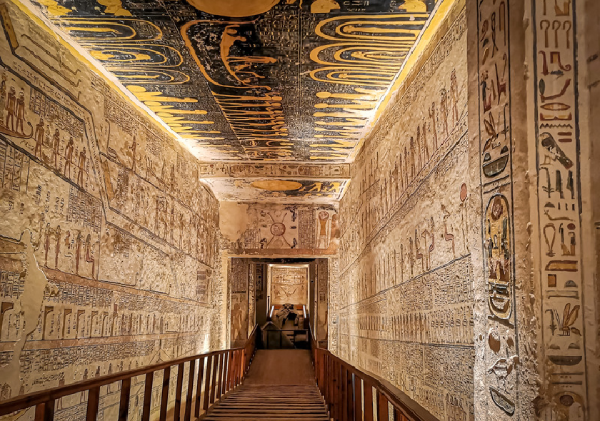
Egypt Luxor Tour takes you to the afterlife of the ancient Egyptians, where kings, queens, and nobles rest on the West Bank of Luxor, considered one of the most famous burial sites in the world. The kings of the New Kingdom (1550–1070 BC) chose this secluded valley as their final resting place, away from the prying eyes of thieves.
Egypt Luxor Tour allows you to explore dozens of royal tombs carved into the rock, including the famous tomb of Tutankhamun. You can wander through the long, multi-chambered corridors of the Valley of the Kings and admire the walls decorated with colorful inscriptions and drawings depicting scenes from the Book of the Dead and the journey to the afterlife.
Valley of the Queens

A 5-minute bus ride from the Valley of the Kings on your Luxor tour of Egypt is the Valley of the Queens, where you can explore more than 90 tombs of queens, princesses, and minor princes.
The Valley of the Queens was dedicated to the burial of the wives and sons of the kings of the New Kingdom (1550–1070 BC). The valley is distinguished by its quiet location and simpler entrances compared to the Valley of the Kings, but it contains some of the most beautifully decorated tombs in ancient Egypt.
The surviving wall decorations of the Valley of the Queens reveal details of royal palace life and burial rituals. During your Luxor tour of Egypt, you will be amazed by the beauty of the most famous tomb in the Valley of the Queens: the tomb of Queen Nefertari, wife of King Ramses II. This is considered an unparalleled masterpiece, with its walls decorated with bright colors and intricate drawings depicting scenes from the Book of the Dead and the queen’s journey to heaven. Not the other.
Amid the corridors of the Valley of the Queens, as part of Egypt Luxor Tour, you will witness the decorations and drawings depicting queens receiving offerings from the gods or performing sacred rituals.
The luxurious clothing and jewelry worn by the women of the palace are also highlighted. There, the Egypt Luxor Tour will give you the opportunity to discover the feminine side of ancient Egyptian civilization, where beauty and sophistication blend with royal power.
Hatshepsut Temple (Deir el-Bahari)
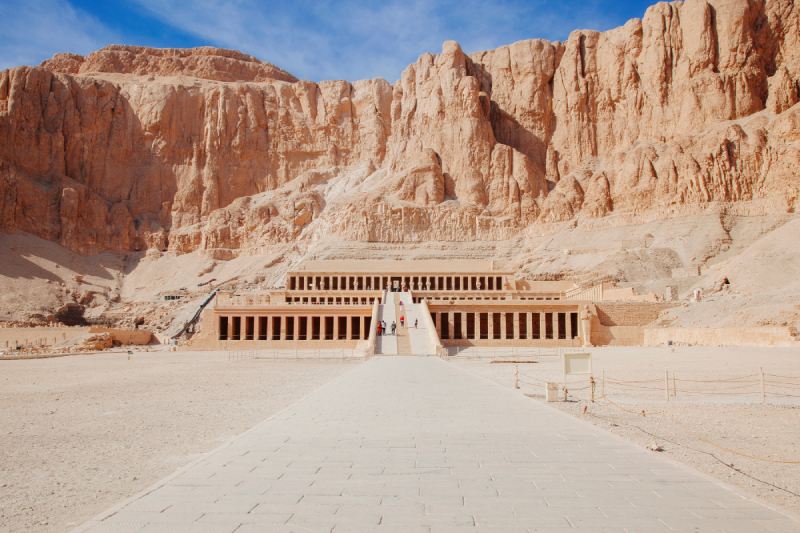
A five-minute bus ride from the Valley of the Queens, the Egypt Luxor Tour takes you to the most successful and powerful pharaonic queen of the Eighteenth Dynasty. To commemorate her memory and honor the god Amun, Queen Hatshepsut.
The walls of her temple are decorated with colorful inscriptions and scenes recounting Hatshepsut’s achievements, including the expedition to the Land of Punt (present-day Somalia) to bring incense and rare wood, as well as scenes of religious celebrations, funeral rituals, and offerings to the gods. These inscriptions are important historical documents for understanding the politics and economy of her reign.
Egypt Luxor Tour offers an opportunity to explore the details of Hatshepsut’s Temple, known as Deir el-Bahari, located on the west bank of the Nile River in Luxor, nestled beneath towering mountain cliffs. It is considered one of the greatest funerary temples in ancient Egypt. You will wander through the temple’s uniquely designed corridors, built on three terraces connected by ramps. This was the work of the architect Senenmut.
The architecture blends harmoniously with the surrounding landscape, with the terraces appearing as an extension of the mountainous rocks behind them, making it an unparalleled architectural masterpiece in Egyptian history.
A visit to Hatshepsut’s Temple as part of the Egypt Luxor Tour gives you a unique opportunity to wander through its wide corridors and ascend its terraces to enjoy a panoramic view of the Valley of the Kings and the farms of the West Bank.
Colossi of Memnon
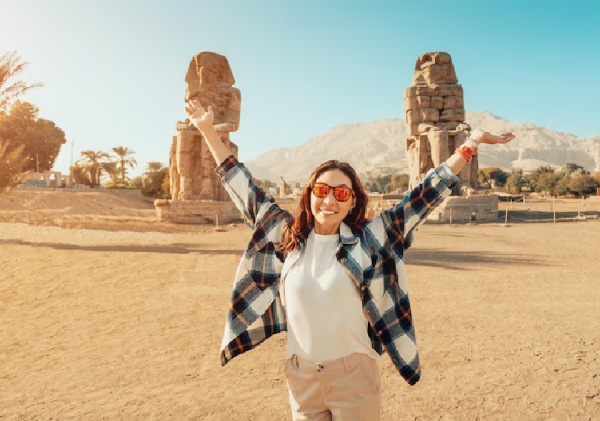
Egypt Luxor Tour takes you on a journey through the legend of the Colossi of Memnon, one of which is famous for making a distinctive sound at sunrise, resembling a melody or a groan. It was believed to be directed by the Greek hero Memnon as he greeted his mother, the goddess Eos, attracting tourists and pilgrims from all over the world. These two Colossi of Memnon stand on the road leading to the Valley of the Kings.
The two colossal Colossi of Memnon, carved from a single block of quartz sandstone, each approximately 18 meters tall, depict King Amenhotep III seated on his throne, his hands on his knees, facing east toward the Nile and the rising sun.
The two statues were erected around 1350 BC as part of the front entrance to the massive mortuary temple of Amenhotep III, which was one of the largest temples in Thebes. However, the temple was destroyed by floods and earthquakes, and only these two statues remain, which have become a distinctive symbol of the region.
Medinet Habu (Ramesseum and Temple of Ramesses III)
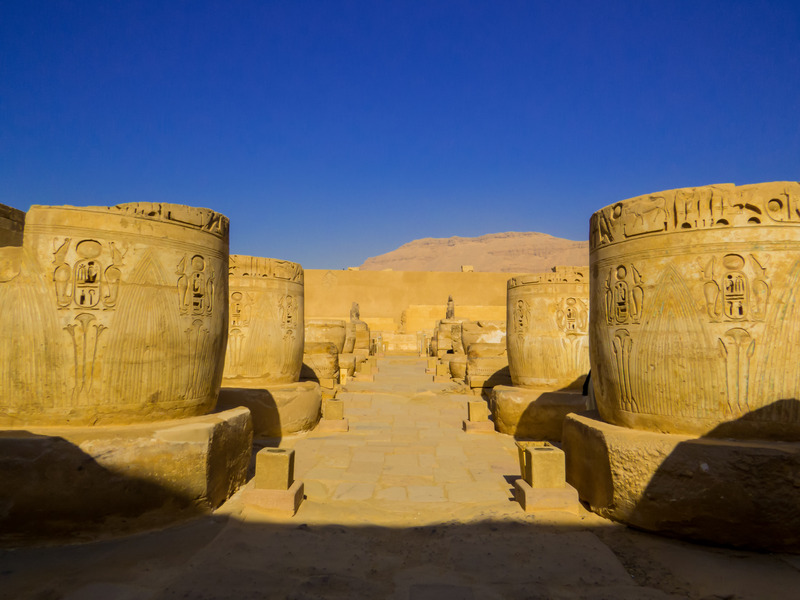
Egypt Luxor Tour takes you on an exceptional experience, immersing yourself in the bas-reliefs depicting the famous battle scenes of Ramesses III against the Sea Peoples at the Temple of Habu, which features hypostyle halls, open courtyards, and inner sanctuaries, in addition to colorful carvings that retain their luster to this day.
The Medinet Habu Temple is located on the West Bank of Luxor, near the Colossi of Memnon, and is also known as the Mortuary Temple of Ramesses III. It is one of the best-preserved ancient Egyptian temples, with its walls, carvings, and bright colors remaining in stunning condition despite being more than 3,000 years old.
As part of Egypt Luxor Tour, a visit to the Temple of Habu gives you the opportunity to discover one of the best-preserved and most detailed temples in Luxor. Visitors can wander through its spacious halls and marvel at its colorful carvings, transporting them directly to the era of the Pharaohs.
Ramesseum Temple:

Egypt Luxor Tour takes you to the Ramesseum Temple to learn about this funerary temple of King Ramses II, one of the greatest and most influential kings of ancient Egypt. You can tour the massive edifice decorated with war scenes recording Ramses II’s victories, and its inscriptions detail the famous Battle of Kadesh against the Hittites.
It also contains a hypostyle hall decorated with reliefs depicting religious and celebratory scenes, as well as walls bearing hieroglyphic texts glorifying the king and his achievements.
Egypt Luxor Tour allows you to stand before the remains of a colossal statue of Ramses II, which stood more than 17 meters tall and weighed nearly 1,000 tons. It is one of the largest statues carved in ancient Egypt and is one of the most prominent landmarks of the Ramesseum Temple. Although it has fallen and disintegrated over time, its remains reflect the pharaohs’ skill in carving and transporting massive stones.
Recent Posts
East Bank Luxor Tour: 5 Unmissable Highlights to Explore
Tour luxor abu simbel : 7 Reasons This Journey Will Amaze You
Luxor Aswan Tour: Top 10 Temples and Tombs to Explore
All Categories
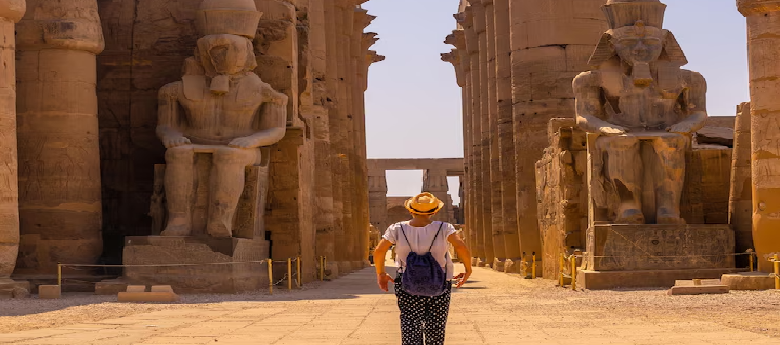
Luxor


